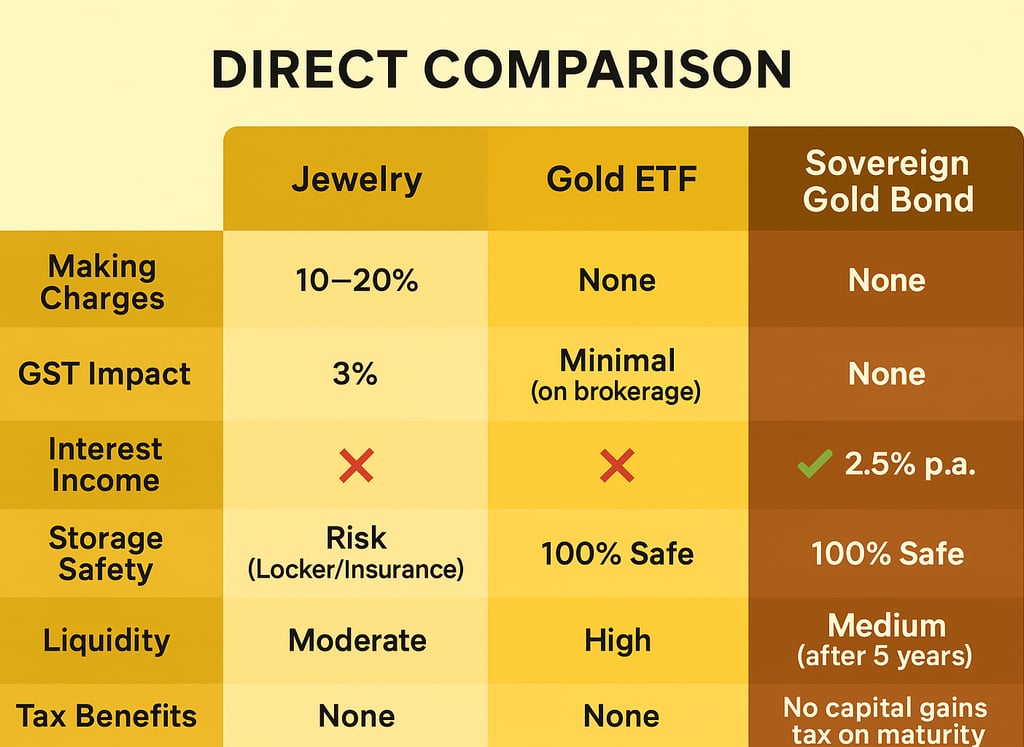Why Investing in Gold ETFs or Sovereign Gold Bonds Instead of Jewelry Is a Smart Move (and How It Cuts Direct Loss)
Jewelry may look beautiful, but it costs you more than you realize. Learn why investing in Gold ETFs or Sovereign Gold Bonds (SGBs) is the smarter, loss-cutting way to own gold in 2025.
RAVINDRA PRAJAPATI (EDUCATIONAL BLOG)
10/18/20252 min read


Introduction: The Emotional vs. Financial Side of Gold
Every festive season — especially around Dhanteras — millions of Indians buy gold jewelry believing it brings prosperity.
But what if that glittering purchase is actually shrinking your wealth instead of growing it?
Gold remains one of the most trusted assets in India, yet how you invest in it matters more than ever.
In today’s smart-investing era, Gold ETFs and Sovereign Gold Bonds (SGBs) offer a modern, cost-effective, and profit-earning way to own gold — without the hidden financial losses that come with jewelry.
Let’s break down why choosing these modern gold options is not just wise — it’s wealth-smart.
1. Jewelry Comes with Hidden Costs That Kill Returns
Buying jewelry is emotional, but it’s far from financially efficient.
When you purchase gold jewelry, you pay:
Making charges (typically 10–20%)
GST (3%) on the total price
Loss on resale value (due to melting & design deduction)
This means your investment starts with an instant 15–25% loss the moment you buy it.
On the other hand, Gold ETFs and SGBs track the actual gold market price, ensuring that your money goes entirely into the value of gold — not craftsmanship.
Smart takeaway: Jewelry is consumption. ETFs and SGBs are investment.
2. Gold ETFs: Real Gold, Real-Time, Zero Hassle
Gold ETFs (Exchange-Traded Funds) are digital instruments that mirror real gold prices on the stock exchange.
You can buy them through your Demat account — just like shares — in small or large quantities.
Benefits of Gold ETFs:
No making charges or purity doubts
Instant buy/sell flexibility (liquidity)
Transparent pricing linked to real market value
Safe — no storage or theft risk
In short, Gold ETFs give you the freedom and precision of stock trading with the stability of gold ownership.
📊 Pro Tip: Many investors use Gold ETFs to hedge against market volatility — especially when equity markets turn uncertain.
3. Sovereign Gold Bonds (SGBs): Gold That Pays You Back
SGBs, issued by the Reserve Bank of India (RBI) and backed by the Government of India, are the most rewarding way to hold gold long-term.
Key Benefits of SGBs:
2.5% annual interest on the invested amount
No capital gains tax if held till maturity (8 years)
Completely digital and risk-free
Redemption at prevailing market price of gold
That means your gold value grows with the market — and you earn interest while you wait.
Smart investor logic: Why just hold gold when it can pay you?
4. Liquidity + Transparency = Smarter Gold Ownership
One major drawback of jewelry is emotional attachment — many investors hesitate to sell even when prices are high.
Gold ETFs and SGBs remove that barrier:
You can trade ETFs instantly at market prices.
You can redeem SGBs easily through banks or brokers after the lock-in period.
No emotional pressure, no middlemen, no undervaluation — just financial clarity.
5. Why 2025 Is the Right Time to Go Digital with Gold
In 2025, global central banks and large investors are already increasing their gold holdings amid inflation fears.
As gold demand rises, digital gold investments like ETFs and SGBs allow you to ride the same wave without the overhead costs of traditional jewelry.
The future of gold investment is digital, safe, and profitable — not ornamental.
Conclusion: Let Your Gold Work for You
Jewelry shines, but Gold ETFs and Sovereign Gold Bonds grow.
They cut unnecessary costs, earn interest, and preserve full gold value — making them the smarter, loss-free way to invest in gold.
Final Thought: This Dhanteras, don’t just buy gold — own it smartly.
Choose Gold ETFs or SGBs and let your gold bring prosperity, not hidden losses.
RAVINDRA PRAJAPATI, Not a sebi registered
FOLLOW Us
ravindra.prajapati1122@gmail.com
+91 9795187745
© 2025. PiPiFinTech All rights reserved.
Contact Us
ABOUT Us
Our mission is to empower you to maximize every single penny and best solution for wealth generation and management for every mature age group.
Product TOPICS
Digital E-Wealth Platform
Mutual Funds
Education Planning
Insurance
FD and Bonds
Retirement Planning
Wealth Creation
(Disclaimers : Mutual Fund investments are subject to market risks, please read scheme related documents carefully.)
